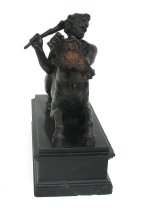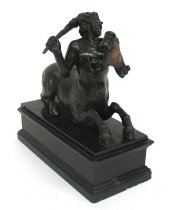Object Record
Images


Metadata
Catalog number |
69.17 |
Artist |
Unknown |
Title |
Centaur |
Date |
ca. 1500s |
Object Name |
Figurine |
Description |
The same innovations which led the Renaissance into the modern world, are characteristic of this bronze as well. The centaur is a classical figure that humanists would have known, since they were well-versed in classical culture. Its patron was probably a person with a classical education. In the ancient world, centaurs represented barbarian forces, as seen on the sculpted metopes of the Parthenon that symbolically represented the battle of the Persians and the Greeks. We cannot say whether the artist or patron intended this centaur to symbolize the barbaric foreigners of their own time, or simply valued it as a generically classical allusion. Lauren Williams, in "SCHOLARS, EXPLORERS, PRIESTS, How the Renaissance Gave Us the Modern World," ex. cat. G -T M, Queens College, CUNY, February 2 - March 27, 2010, 43. |
Medium/Material |
Cast bronze |
Dimensions |
H-8 inches |
Search Terms |
Renaissance 16th century AD Europe Italy Mythological Figurine Greek and Roman Metalwork, bronze |
Exhibition and Publication History |
* "SCHOLARS, EXPLORERS, PRIESTS, How the Renaissance Gave Us the Modern World," Curated by James M. Saslow, G -T M, Queens College, CUNY, February 2 - March 27, 2010, # 43, ill. |
Culture |
Italian |

